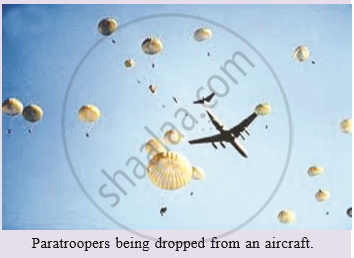Advertisements
Advertisements
Question
A 150 g ball, travelling at 30 m/s, strikes the palm of a player’s hand and is stopped in 0.05 second. Find the force exerted by the ball on the hand.
Solution
Mass of the ball, m = 150 g = 0.15 kg
Initial velocity of the ball, u = 30 m/s
Initial momentum of the ball, pi = mu = 4.5 kg.m/s
The player’s hand stops the ball in 0.05 s.
Thus, final momentum of the ball is, pf = 0
So, change in momentum of the ball = pf − pi
= 0 − 4.5
= −4.5 kg.m/s
So, rate of change of momentum is = −4.5/0.05 = −90 N
This is the force exerted by the hand on the ball.
So, the force exerted by the ball on the hand is = 90 N
APPEARS IN
RELATED QUESTIONS
Two objects, each of mass 1.5 kg are moving in the same straight line but in opposite directions. The velocity of each object is 2.5 m s−1 before the collision during which they stick together. What will be the velocity of the combined object after collision?
Figure shows the position-time graph of a body of mass 0.04 kg. Suggest a suitable physical context for this motion. What is the time between two consecutive impulses received by the body ? What is the magnitude of each impulse ?

Figure shows a man standing stationary with respect to a horizontal conveyor belt that is accelerating with 1 m s–2. What is the net force on the man? If the coefficient of static friction between the man’s shoes and the belt is 0.2, up to what acceleration of the belt can the man continue to be stationary relative to the belt? (Mass of the man = 65 kg.)

Name the physical quantity which is considered to be a measure of the quantity of motion of a body.
state whether momentum is scalar or vector.
What is the change in momentum of a car weighing 1500 kg when its speed increases from 36 km/h to 72 km/h uniformly ?
Which physical quantity corresponds to the rate of change of momentum ?
Fill in the following blanks with suitable words :
Momentum is a _____________ quantity. Its unit is _____________.
The troops (soldiers) equipped to be dropped by parachutes from an aircraft are called paratroopers. Why do paratroopers roll on landing ?
A boy of mass 50 kg running at 5 m/s jumps on to a 20 kg trolley travelling in the same direction at 1.5 m/s. What is their common velocity ?
